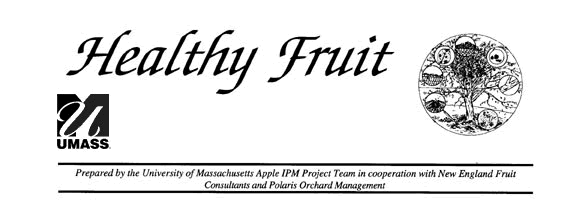
|
|
|---|
Even in the latest-developing areas of the state, the New York weather model predicts that the threat of plum curculio activity has passed (340 DD reached on 6/12). As mentioned last week, growers who had an active residual cover in place through the weekend should be clear of any further PC injury.
No second-generation leafminer adults have been observed thus far. Through 6/11, the vast majority of mines observed on fruit cluster leaves had halted in the sap-feeding stage, which is typical in blocks treated with Provado or Agri-Mek. Less than 5% of first-generation mines have apparently survived in treated blocks, and most survivors have progressed through the tissue-feeding stage. Although it is too late for any further control of the first generation, an estimate of the surviving potential for damage can be gained by counting mines that have developed into tissue feeders.
Recommended thresholds for treatment are 7 tissue-feeding mines per 100 leaves (for McIntosh) or 14 tissue-feeding mines per 100 leaves (for non-McIntosh varieties). If the number of surviving mines exceeds these thresholds, a treatment of Provado, Agri-Mek, SpinTor, or Lannate can be relatively effective, if applied when second-generation sap-feeding mines begin to appear.
This season, we have seen very little buildup of red mites in blocks that received a full oil program or an early-season acaricide. However, hatch of the first summer generation continues, after which there is an increased threat of rapid population development, especially in blocks that only received oil.
In one monitored site, which received a double-oil program under poor weather conditions, the mite population has already exploded (exceeding 50 ERM/leaf), resulting in early bronzing. Growers should keep an eye out for the rapid multiplication of mites which is typical of hot, dry summer conditions. Dry summer weather typically stimulates ERM to feed more aggressively, and suppresses development of fungi, some of which are marginally effective pathogens against ERM. If a summer treatment targeting ERM is deemed necessary, the options are Carzol, Kelthane, Apollo, and Pyramite.
The season's first apple maggot fly was captured 6/14 (in a curculio trap), which would suggest that the next week or so is a good time to prepare for placement of monitoring spheres. Recommendations for trap placement and distribution will appear in next week's issue. For reference (with no guarantees), we expect that the AMF population will fall in line with that of plum curculio: greatly reduced after last year's lack of untreated egglaying sites.
From one year to the next, it is nearly impossible to predict the threat posed by potato leafhopper invasion. It is known that they immigrate over long distances, primarily from regions to the south and west of Massachusetts, and that they pose the greatest threat to young, nonbearing trees. Mature, fruiting trees are at very little risk of PLH damage, with the exception of mild discoloration of terminal leaves. New plantings, however, are prone to heavy damage to terminal growth, which can stunt the photosynthetic capability and growth of the tree.
When the population of PLH reaches a damaging level, terminal leaves will curl, with discoloration ranging from yellowing at the mid-rib to browning of the leaf margins. Such damage can appear at an alarming rate in young trees, and may be confused with viral infections. If PLH damage becomes an issue, a single treatment of Thiodan or Sevin should remedy the problem.
Moderate populations of rose and white apple leafhoppers have been seen in sites throughout the state. Treatments aimed at controlling adult leafhoppers are generally ineffective, as nymphal stages are much more susceptible to treatment with either Thiodan or Sevin. Because of this, we do not recommend treatment until late June, when the next generation's nymphs are present.
Healthy Fruit is written by Dan Cooley, Ron Prokopy, Starker Wright, Wes Autio, and Duane Greene except where other contributors are noted. Edited by Dan Cooley. Publication is funded in part by the UMass Extension Agroecology Program, grower subscriptions, and the University of Massachusetts IPM Program. A text version can be e-mailed to you if you contact Doreen York. Please cite this source if reprinting information.